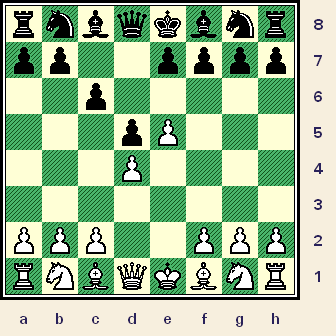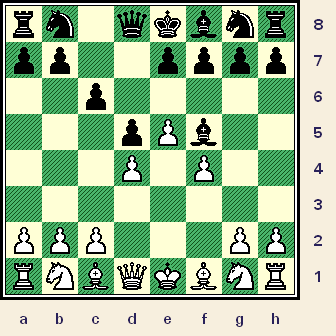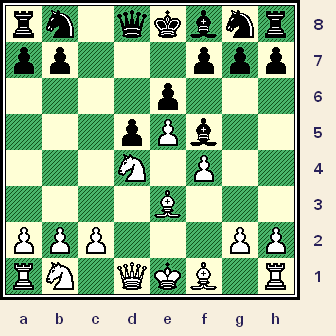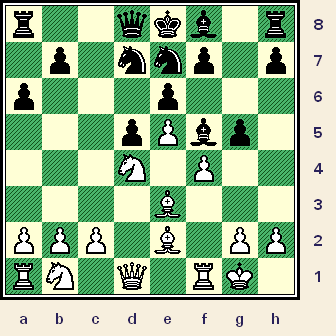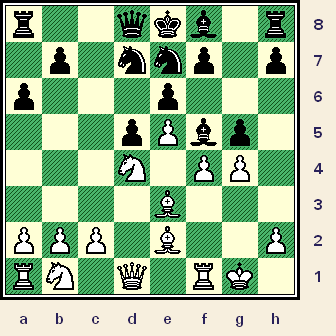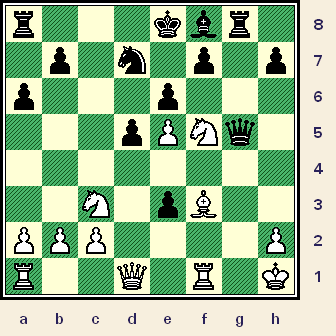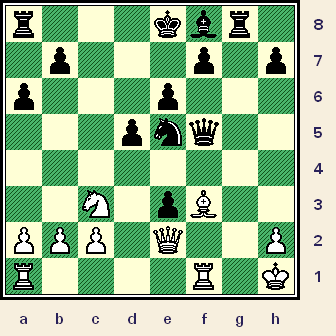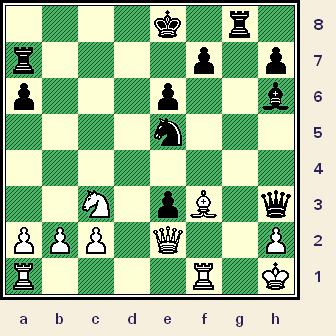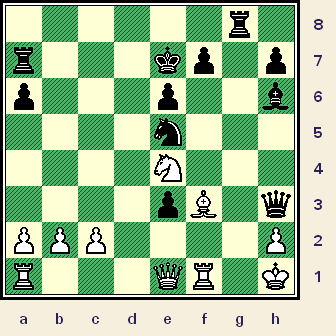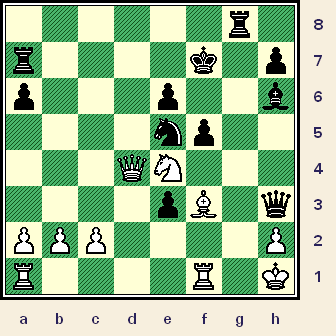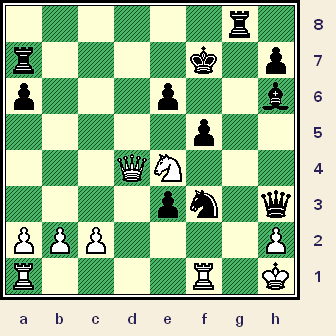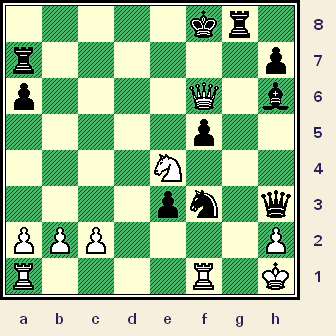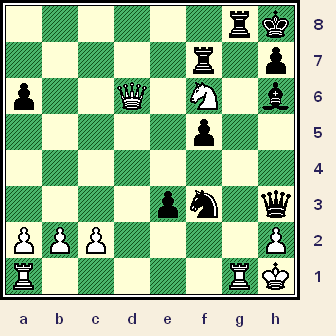GM Alexander Morozevich (2758) -
GM Vassily Ivanchuk (2705)
|
|
|
*********************
GM
Alexander Morozevich probably
chose this move as a big surprise
weapon ...
to get Ivanchuk out of
his carefully prepared 'book' lines.
[ Recent practice has also seen
White try the continuation:
4.h4 h6; 5.g4 Bd7; 6.Nd2,
"~" (TN) {Diagram?}
with a position that I interpret
as being wildly unclear.
GM V. Kramnik - GM P. Leko;
World Championship Match / Game #14
Brissago, SUI; 2004.
(1-0, 41 moves.); [ See
this game. ]
*********************************************************************
Another pathway, that is used
more frequently than the game
continuation, would be:
4.Nf3!? e6; 5.Be2 c5;
{Diagram?}
This seems like the correct idea
(to me) for Black in this position.
** ** ** ** ** ** ** ** ** ** ** ** ** ** ** ** ** ** ** ** ** ** ** ** ** **
( Instead Black can play: (</=) 5...Nd7!?; 6.0-0 h6;
{Diagram?}
but White gets a fairly large
edge ("+/=") in this line.
See "Nunn's Chess Openings," page # 145, line/row # 05. )
** ** ** ** ** ** ** ** ** ** ** ** ** ** ** ** ** ** ** ** ** ** ** ** ** **
6.0-0 Nc6; 7.c3 Bg4;
8.Nbd2 cxd4; 9.cxd4 Nge7; 10.a3!? Nf5;
11.b4 Be7;
12.h3 Bxf3;
{Diagram?}
The end of the column.
13.Nxf3 0-0; 14.Bb2 a6;
{Diagram?}
This was all played in the game:
GM N. Short - GM A. Karpov; (2)
/
(FIDE) Candidates Match (sf1)
Linares, ESP; 1992.
(The game was drawn, 1/2-1/2; in 32 moves.)
Now the respected reference
work recommends that the first
party uses the move:
15.Bd3!?,
"+/=" ('!') {Diagram?}
with a solid edge for White.
[ See MCO-14, page # 185; column # 44, & also note # (k.). ]
"White's Kingside possibilities put him on top." - GM N. de Firmian ]
Play now proceeds in a relatively
normal manner, at least for the
next few moves.
4...e6;
5.Nf3 c5!?;
It seems to make sense to get
this break in as soon as possible,
although Black had other fairly
playable options in this position.
[ Black can also try:
5...Nh6!?; 6.Be2 Qb6;
7.0-0 c5; 8.c3 Nc6; 9.Kh1 cxd4; 10.Nxd4,
{D?}
This is probably best.
( </= 10.cxd4?! Bg4!; "=/+" )
10...Bc5; 11.Nxf5 Nxf5;
12.Bd3 g6!?; "~"
{Diagram?}
Black has a fully playable game.
(GM M. Filip gives the evaluation
symbol that means,
"Black is
better" here. Fritz 8.0, after about
ten minutes,
awards a very slight
edge to White. My evaluation of
unclear falls between these two
vastly differing assessments.
If
12.a4, then 12...a5; 13.Qe2.)
E. Schiffers - V. Jurevic' / 03 RUS Champ, Kiev; 1903.
[ See ECO, Volume "B" (II) /
Lines for B12, page # 86.
Line/row # 06, and all notes.
See - especially - note # 21,
on page # 88. ] ]
6.Be3,
It seems unusual not to protect
the base of your pawn chain
with another Pawn, (c2-c3).
However, in this position that
might not be a good idea, since
White would then have slightly
weakened the light squares,
(even more); and also the first
player has used five tempo on
non-developing, pawn pushes.
[ If White were to play:
(</=) 6.c3!?, then simply:
6...Nc6!;
"=" {D?}
with few problems for Black.
********************************************************
Another possibility would be:
6.Nc3 Nc6; 7.Be3 Bg4; 8.Be2 Nh6!?; 9.dxc5 Bxf3;
10.Bxf3 Nf5;
11.Bg1 g5!?; 12.Qd3,
"~" {Diagram?}
A very vague position has arisen,
it is very difficult to divine who is
better here ...
although White did
manage to win in just 28 moves.
GM Julio Granda Zuniga
(2605)
-
NM Pedro Aderito
(2260);
36th World Team Championships / (FIDE Olympiad in Calvia)
Mallorca, ESP; 2004.
(1-0, 28 moves.) ]
6...cxd4!?;
(TN?)
I don't know if it is such a great
idea to bring White's Knight to
the d4-square here ...
but this is
exactly what Ivanchuk does.
One of the positive facets of this move is that Black has begun to undermine White's Pawn wedge in the center of the board.
Another reason that Ivanchuk
might have played this particular
try, was to get away from known
'book' theory.
(As far as I could tell, there were
no other games in the db with ...cxd4; that involved MASTERS!)
[
Fritz likes the move: 6...c4!?;
"~" {Diagram?}
but I doubt that this move would
greatly worry a player of the
White pieces,
as the first player's
center is left completely secure.
**************************************************************
The only other game that I could
find in the database - that at
least one of the
players had a
solid FIDE rating - was the
following interesting contest:
6...Nc6!?; 7.dxc5!? Qa5+?!;
8.c3 Bxc5; 9.b4 Nxb4;
10.cxb4 Bxb4+; 11.Bd2 Rc8;
12.Nd4!?, '±' (Maybe "+/-")
{Diag?}
and although White seems to
be clearly much better here ...
the first player - somehow -
found a way to lose from this
crazy position.
Hannes Stefansson
(2385) -
Per. Johansson (????);
/ ICT / Masters
(Open?)
Gausdal, Norway; 1986.
/ (Black won, 0-1, in 52 moves.) ]
7.Nxd4,
"+/=" (radial power)
{See the diagram ... just below.}
Take a look at White's Knight ...
sitting pretty in the middle of the
chess board here.
*********************
*********************
In this position, Fritz awards the first player a solid advantage.
[ Possible was: 7.Bxd4!?, ("=") ]
7...Ne7!?;
(D-fence!)
While It is probably OK for Black
to swap the Bishop on f5 here
for a Knight ... it probably is not
a good idea to allow White to
corrupt Black's Pawn skeleton
this early in the game.
[ The alternative was: 7...Nh6!?; {Diagram?} to defend the f5-square. ]
Now Deep Junior likes Nc3,
but Morozevich goes his own
way in this position.
8.Bb5+!? Nd7;
9.0-0 a6; 10.Be2 g5!; (Why?)
{See the diagram ... just below.}
It makes sense - especially in
this position to try and break
down White's strong pawn chain
in the center of the board.
This
move has the added benefit of
opening the g-file as well.
*********************
|
|
*********************
The
game has gotten incredibly
complicated ... in a big hurry. It
is also a fairly original arrangement,
I cannot recall ever seeing a
position anything like this in
GM practice ... ever!
[ Playable was: 10...Qc7!? ]
11.g4!?,
('?!')
(urgh)
{See the diagram ... just beneath the
paragraph below.}
Why would White play this
move? ... It seems doubly wrong
to possibly allow an open g-file
in this position!
(King on g1.)
{This move also has a negative
impact on the scores - by the
computer - of this whole position.
And although
it is not a dramatic shift,
it does not bode well for the evaluation
of this particular move, here.}
*********************
*********************
This is as odd as a position as I have ever seen from an opening, especially after only eleven moves. What is really curious is that this is not a clash between two club players, both contestants have 2700+ ratings!
[ Much better was:
>/= 11.fxg5 Nxe5; 12.Nd2,
"+/=" {D?}
White has a small edge. ]
11...gxf4!;
(Probably - '!!')
Black boldly sacrifices a piece
for play ... no doubt this was all
calculated in advance.
{A prepared variation?}
[ After the plain: </= 11...Bg6?; 12.f5, '±' {Diag?} White is clearly on top. ]
12.gxf5 Nxf5!?;
('!')
Ivanchuk continues on his very
daring path.
[ After the moves:
(</=) 12...Rg8+!?;
13.Kh1 fxe3; 14.fxe6,
"~" (Maybe "+/=")
{Diag?}
... the open lines and edge in
space will tend to favor White,
(in the long run).
*****************************************************************
Another possibility for Black was:
"=" 12...fxe3!?;
13.fxe6 Nxe5; 14.exf7+ Nxf7; 15.Nc3,
"~" ("+/=")
{D?}
White is probably a little better,
Black's shattered Pawn skeleton
does not
inspire confidence. ]
13.Nxf5 fxe3!;
14.Nc3!?, ('?!')
An unfortunate decision ...
Nd6+ seems to have been a
trifle better here.
(White seems
to be unsure of himself at a
critical juncture in the game.)
This move could easily be awarded
the dubious appellation here ... the
change in the "scores" of the
'evals' of various computer programs is
fairly large and significant. (At
least half a pawn here.)
[
After the moves:
>/= 14.Nd6+ Bxd6;
15.exd6,
"+/=" {Diagram?}
we have an interesting position
and Black has many fascinating
tries,
(...Qb6!?; ...Qh4; ...Ne5!;); but this still appears to be a
small, (but solid); improvement over the
course of the actual game.
I am sure that both players saw this
line. My only question is what was
the main reason that Morozevich
avoided this continuation?
************************************************************
A mistake for White would be:
</= 14.Nxe3? Bc5;
15.Kh1, {Dg?}
Apparently White must let
the piece go here.
*****
( No good for White is:
15.Rf3?! Qg5+; 16.Rg3 Bxe3+;
17.Kh1 Qxe5; ("-/+) {D?}
** ** ** ** ** ** ** ** ** ** ** ** ** ** ** ** ** **
Also unsatisfactory would be:
15.Qd3? Nxe5; 16.Qc3 Qg5+; 17.Kh1 Bxe3; ("-/+")
{D?}
Black is winning in both cases. )
*****
15...Bxe3; 16.Bh5 Nxe5; 17.Bxf7+ Nxf7;
18.Qf3 Qd7; {D?}
Black is clearly much better.
("/+") ]
14...Rg8+;
15.Kh1!? Qg5!; 16.Bf3?!, (Probably - '?')
{See the diagram ... just below.}
White decides to return the
piece ... why, I have no clue.
(Morozevich either miscalculated,
or tried a wild gambit - that just
falls on its face.)
*********************
|
|
*********************
Of
course I want to make it very
clear that this is an EXTREMELY
('!!!') complicated position and that
Morozevich had
to analyze the best
that he could, and then make a
decision. He took a risk ... and it
just turned out to be a bad one.
(Of course, had he won brilliantly -
I would have been singing his
praises to the skies ...
just like everyone else!)
It is relatively easy to sit at home,
relaxing in your favorite chair, look
at a game ... with a chess program
busily humming
away, checking
all of your ideas. To sit at the board,
and try to play ... this is a very hard
and difficult thing to do sometimes.
To compound White's situation ... he may have been trying hard to win, for the sake of national pride. And almost certainly the chess clock played a role somewhere during the course of events, as this particular contest unfolded.
[ Was the continuation ... that
began with the move
>/= 16.Ng3,
"~" {Dm?}
an improvement over the game?
(I think it had to be.) ]
16...Nxe5!;
(Natch!)
{Diagram?}
"Chucky" avoids any devious
plans that his opponent might
have had for his early demise.
[ Of course not:
</= 16...Qxf5?;
17.Bh5!,
'±' {Diag?}
when White may be just
winning from this position. ]
17.Qe2,
{Box?}
The program, {Fritz 8.0}; says
that this move is best here.
[ The Knight move was interesting
here ... but after the moves:
("=") 17.Ng3!?
0-0-0!; 18.Qd4 Kb8; 19.Be2 Bd6; "/\"
("=/+")
{Diag?}
Black stands well. The second
party has three solid buttons for
the sacrificed
Knight, and also
good play as well. ]
17...Qxf5;
(ouch)
{See the diagram ... just below.}
Take a good, long look at this
position.
*********************
|
|
*********************
Black is three pawns ahead!!!!!
How is it possible to so completely outplay a 2750+ opponent with
the BLACK pieces ...
in LESS than
twenty moves??? (All the GM's I
have ever talked to, have told me
that Ivanchuk
is a real chess genius.
Here you see the proof of that
rather bold statement.)
Now White regains at least
two of the Pawns ... but it may
not be enough.
18.Bxd5,
{Box?}
This looks like practically the
only move for White.
(Moro
regains at least one of the
fallen foot-soldiers.)
[ White falls into a hole with:
</= 18.Qxe3?! Qg5!; 19.Qe2[],
{D?}
This is probably forced.
***
( After the moves: </= 19.Qxg5? Rxg5; 20.Be2 Rc8; 21.Bd3 Bb4;
22.a4!?,
22...Bxc3; 23.bxc3 Rxc3; 24.Rab1 Rc7; ("-/+")
(3 whole foot soldiers!)
White's position is a wreck, and he is just down too many pawns. )
***
19...Bc5!; 20.Rae1 Nxf3;
21.Qxf3 0-0-0; ("-/+")
{Diagram?}
Black is just two Pawns ahead. ]
18...Qh3;
19.Bxb7 Ra7!;
Attacking the Bishop ... and also
defending his position laterally.
[ Also possible was: 19...Rd8!?, "+/=" ]
White's next move is close to
being forced, albeit the play of
Bishop-g2 was also a possibility.
20.Bf3 Bh6!?;
(Maybe - '!!')
{See the diagram ... just below.}
Black decides to keep the button
on e3 here. This is an important
strategical decision,
and will have
a large impact on the long-term
plans of both players.
{The move of ...Be7; also comes
under serious consideration here.}
*********************
|
|
*********************
This play is more than good enough
for at least a small advantage ...
and given the course of the
game,
it could be exceedingly
brilliant. (Beyond the scope of
the computer to assess things.)
However, I would be failing you
as an annotator of I did not
point out a very simple line, that
guarantees a large edge for
Black, (and is - quite possibly -
an improvement over the game).
[ Maybe
a little more accurate was:
>/=
20...Rd7!;
{Diagram?}
Now Black has the obvious threat
of ...Rd2; winning the game.
Curiously, White has no good way
of meeting this incursion.
21.Qxa6!?,
{Diagram?}
This is not forced, however it is
the first choice of the computer ... by a very wide margin.
*******
( Not to be recommended is: </= 21.Rad1? Nxf3;
('!') {Diagram?}
The simplest and best.
22.Rxf3?! Rxd1+; 23.Nxd1 Qg4; {Diagram?}
Suddenly White cannot defend
against a basic threat. ("-/+")
****************************************************************
The simplest defense to the
threat of Rd2 fails to a very
simple tactic by Black.
21.Ne4 Be7!; 22.Qxe3?! Rg2!; 23.Qf4[] Nxf3; 24.Rxf3 Rxh2+;
25.Qxh2,
25...Qxf3+; 26.Qg2 Qxg2+; 27.Kxg2 f5; 28.Nc3 Rd2+;
29.Kf3 Rxc2; "/+"
Black is obvious much better -
most programs consider the
second player to be
winning,
("-/+"); from this position. )
*******
21...Nxf3; 22.Qa8+ Ke7;
{Diagram}
Now if White plays Qa3+?, Black
can run away via f6-g7-h8, etc.
Now White's next move is forced.
23.Qxf3 Qxf3+; 24.Rxf3 Bh6;
25.Raf1 f5; 26.Rh3 Rg6;
27.a4!? Rd2!; "=/+"
(Probably - "/+") {Diagram?}
Black is clearly better here.
[Black has fantastic play from
here, White's Q-side Pawns
appear ready to fall.
However,
this line may have been nearly
impossible to calculate (OTB)
if Ivanchuk
was short of time.]
I spent quite some time verifying
this line, using several different
programs. Additionally,
I even did
a few "program-vs.-program"
tests from the final position, Black
easily won
all of these. {A.J.G.}
]
21.Ne4
Ke7[]; {Box.}
To avoid a Knight fork on f6.
22.Qe1!,
{See the diagram just below.}
Morozevich has hardly given up
on this position; no, no, not at
all. Here White sets a trap for
his opponent,
and offers the
Bishop on f3 as bait.
*********************
*********************
However, just because the box also approves of this move does not mean that it is best, I felt that a more cautious defense (c3 or c4) was in order. The real danger with a move like Qe1 is that if White's attack runs out of gas, he goes down in flames. (Qe1 is definitely a move that attempts counterplay at any cost. This is known - chessically speaking - as, ... ... ... "Burning all of your bridges behind you.")
[ After a move like:
</= 22.Rad1!?,
(Probably - '?!')
{Diagram?}
White is in a bad way, Black
now has a number of ways
to gain the advantage,
(...f5; or ...Bf4;). ]
22...f5!?;
(WILD!)
Things get really hairy after
Ivanchuk plays this move.
(White might be able to force
a draw after this move.)
*********************
[ Incredibly naive would be:
</= 22...Nxf3?;
('??') 23.Qb4+! Kd7;
24.Rad1+,
("=") {Diagram?}
and White has at least enough
play to draw the game from
this particular position.
[ I probably spent more than
thirty minutes working out
all the lines. Then I went
back
and deleted them. Why?
A.)
They are long and tortured;
B.)
This is a good position for
you to practice your analytical
skills. Barring that,
fire up your
favorite chess program ... and
work it out yourself!! ]
*********************************************************************
*********************************************************************
The box (Deep Fritz) prefers the move ...Rb7 here for Black.
For example:
>/= 22...Rb7!;
('!!') {Diagram?}
This stops any thought of
Morozevich ever playing the
move of Qb4+ for White.
*******
The rest of the moves in this
line took over an hour to work
out, even
with the computer's
help here! (I was trying to gain
an understanding
of the ideas
and variations. I worked many
of the individual sub-lines
out,
but deleted them in the final
version of this contest ...
as they
are not really necessary.)
23.Qe2 Rd7!!; 24.Nf6! Rg3!;
25.Nxd7!? Nxf3!; 26.Nb8 Bf4!;
27.Nc6+ Kf8!;
"~" ("--->") {Diagram?}
My analysis clearly indicates
that despite the second player's
slight material
disadvantage, that the impending assault will
completely overwhelm White.
(Black is winning, or "-/+")
]
*********************
23.Qb4+ Kf7[];
(Of course!)
Not much choice here.
[ It would be insanity to play:
</=
23...Kd7??; 24.Qd4+! Kc8!?; 25.Nd6+ Kd8;
26.Nxf5+ Nd7[];
27.Nxh6 Qxh6; 28.Qxa7,
"+/-" {Diag?}
and White has an easy win. ]
24.Qd4!?,
(ugh!)
{See the diagram ... just below here.}
This is a VERY plausible looking
move, but one that is highly
doubtful. {Maybe - '?!'}
(Of course, Morozevich may have
been pressed for thinking time
when he played this
particular
move in this position.)
*********************
|
|
*********************
White
can now force a draw ...
and should probably do so.
(Any
talk of White winning this position
is simple foolishness.)
[ White can split the point with:
24.Nd6+ Kf6; 25.Ne4+ Kf7;
{Diag?}
This is probably best here.
( NOT </= 25...fxe4??; as 26.Bg4+,
{D?}
will win the White Queen. ("+/-") )
26.Nd6+ Kf6; 27.Ne4+, ("=") {Diag?} and it is time to shake hands. ]
24...Nxf3!!,
(Wow!!)
{See the diagram ... just below.}
This just looks like a blunder ...
I got many e-mails from friends
and students asking why
White
could not just grab the Rook. (What?!? Don't any of you guys
own a chess program?)
*********************
|
|
*********************
However
- with best play by BOTH
parties - I was finally able to
determine that the game should
probably end in a draw from here.
[ Was 24...Bf4!?; {Dm?} playable here? ]
25.Qf6+,
This looks to be best or forced.
**************
[ Now White probably saw what he must have missed in his earlier calculations.
For example:
</= 25.Qxa7+?
Kg6!!; {Diagram?}
Shocking, wouldn't you agree?
(But wait! There is more!!)
26.Rg1+!? Kh5!!;
{Diagram?}
and Black's King is (now)
completely safe ... and White
is unable to defend
all of
Black's threats.
("-/+") {If Ng3+, then simply ...RxN!}
************
( After the following moves:
26...Kh5!!; 27.Qf7+ Kh4!;
28.Qe7+ Rg5;
29.Qd6 fxe4; 30.Qf4+ Kh5;
31.Rxg5+ Bxg5; 32.Qc7,
{Box?} {D?}
This is practically forced.
( After the moves: </=
32.Qg3?! Qxg3; 33.hxg3 e2; ("-/+") {D?}
Black will promote the e-pawn,
and be two pieces ahead in the
resulting endgame. )
32...e2; 33.Qxh7+ Bh6;
34.Qf7+ Kg5; 35.Qg8+ Kf4;
("-/+") {Diag?}
And since White cannot check
on the f8-square, Black will win
easily from this
position. (The
first party must defend against
a mate on the h2-square and
also
prevent the Black e-pawn
from promoting ... all of this is
a completely
impossible task.) )
]
**************
The next few ply all appears to
be either forced or best.
25...Ke8;
26.Qxe6+ Kf8; 27.Qf6+??, (ACK!!!)
{See
the diagram ... just below.}
Probably in time pressure, 'Moro' blunders and throws away the
almost certain half-point.
*********************
*********************
Of
course it is easy to criticize ...
to play this game must have been
thousands of times more difficult.
(One Internet source said that
this struggle was one of the most
watched contests of the whole FIDE
Olympiad, and had a truly GLOBAL
audience!!)
[ After the following continuation:
>/= 27.Qc8+! Kf7;
28.Qc4+ Kg7; 29.Qc3+ Kg6; 30.Qc6+ Kh5!;
{Dm?}
The only real try here.
( After: 30...Kf7!?; 31.Qc4+, {Diagram?}
the game is an almost certain
draw, White checks
until his opponent realizes this as well. )
31.Nf6+ Kh4; 32.Qxf3 Qxf3+;
33.Rxf3 Rf8!?;
"~" (Probably "=")
{D?}
the game appears headed for
the land of draws. ]
Now one could split hairs over
the next few moves ... but it no
longer matters.
White's game is
already beyond salvation here.
27...Rf7;
28.Qd6+!? Kg7; 29.Rg1+!? Kh8; 30.Nf6?,
{See the diagram ... just below here.}
Morozevich must have realized
(now) that he was lost, and given
up the ship. (White RESIGNS.)
{Or perhaps Morozevich simply
lost on time in this position.}
*********************
*********************
White's last move was yet another blunder ... that walked into a certain and unstoppable mate.
[ White could have avoided mate
by playing the moves:
>/= 30.Rxg8+
Kxg8; 31.Qb8+ Kg7; 32.Qg3+ Qxg3;
33.Nxg3 f4; 34.Ne2 Nd2;
("-/+") {Diagram?}
but still faces certain defeat from
the current position, that
we now
have, on the chess-board.
************************************************
After the faulty:
</= 30.Nf6? Nxg1!;
31.Rxg1!? Qf3+; ("-/+")
{Diag?}
... White will be check-mated
on the very next move. ]
****************************************************
A monumental struggle ... that was
enormously complicated ... and was
probably played under extreme
tension by both parties. It also
played a very crucial role in the
eventual determination of each
team's fate
and who won medals.
It wasn't perfectly played ... but this
contest had many redeeming qualities
for me, at least from the annotator's
perspective. (High fighting content,
originality, massive complexity.
AND ... it was just plain fun!)
0 - 1
*******
Copyright (c) A.J. Goldsby, 2004. All rights reserved.
This game - the HTML code - was originally generated by the program, ChessBase 8.0.
